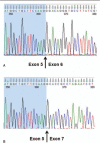Hereditary spastic paraplegia due to a novel mutation of the REEP1 gene: Case report and literature review
- PMID: 28099355
- PMCID: PMC5279100
- DOI: 10.1097/MD.0000000000005911
Hereditary spastic paraplegia due to a novel mutation of the REEP1 gene: Case report and literature review
Abstract
Rationale: Hereditary spastic paraplegia (HSP) is a heterogeneous group of diseases little known in clinical practice due to its low prevalence, slow progression, and difficult diagnosis. This results in an underestimation of HSP leading to belated diagnosis and management. In depth diagnosis is based on clinical presentation and identification of genomic mutations. We describe the clinical presentation and pathogeny of HSP through a report of a case due to a novel mutation of the REEP1 gene (SPG31).
Patient concerns: A 64-year-old woman presented gait disturbances due to spasticity of the lower limbs progressing since her third decade. Previous investigations failed to find any cause.
Interventions: DNA analysis was performed to search for HSP causing mutations.
Diagnoses: A novel heterozygote mutation (c.595 + 1G>A) of the REEP1 gene, within the splice site of intron 6, was discovered. This nucleotide change causes exon 6 skipping leading to frame shift and a truncated transcript identified by complementary DNA sequencing of reverse transcription polymerase chain reaction products.
Outcomes: REEP1 is a known protein predominantly located in the upper motor neurons. Mutation of REEP1 primary affects the longest axons explaining predominance of pyramidal syndrome on lower limbs.
Lessons: Slow progressive pyramidal syndrome of the lower limbs should elicit a diagnosis of HSP. We describe a novel mutation of the REEP1 gene causing HSP. Pathogeny is based on resulting abnormal REEP1 protein which is involved in the development of longest axons constituting the corticospinal tracts.
Conflict of interest statement
The authors have no conflicts of interest to disclose.
Figures



Similar articles
-
A complete overview of REEP1: old and new insights on its role in hereditary spastic paraplegia and neurodegeneration.Rev Neurosci. 2020 May 26;31(4):351-362. doi: 10.1515/revneuro-2019-0083. Rev Neurosci. 2020. PMID: 31913854 Review.
-
REEP1 mutation spectrum and genotype/phenotype correlation in hereditary spastic paraplegia type 31.Brain. 2008 Apr;131(Pt 4):1078-86. doi: 10.1093/brain/awn026. Epub 2008 Mar 5. Brain. 2008. PMID: 18321925 Free PMC article.
-
Autosomal dominant hereditary spastic paraplegia: novel mutations in the REEP1 gene (SPG31).BMC Med Genet. 2008 Jul 21;9:71. doi: 10.1186/1471-2350-9-71. BMC Med Genet. 2008. PMID: 18644145 Free PMC article.
-
Spastic paraplegia type 31: A novel REEP1 splice site donor variant and expansion of the phenotype variability.Parkinsonism Relat Disord. 2018 Jan;46:79-83. doi: 10.1016/j.parkreldis.2017.10.012. Epub 2017 Oct 21. Parkinsonism Relat Disord. 2018. PMID: 29107646
-
Hereditary spastic paraplegia: clinico-pathologic features and emerging molecular mechanisms.Acta Neuropathol. 2013 Sep;126(3):307-28. doi: 10.1007/s00401-013-1115-8. Epub 2013 Jul 30. Acta Neuropathol. 2013. PMID: 23897027 Free PMC article. Review.
Cited by
-
Three novel mutations in 20 patients with hereditary spastic paraparesis.Neurol Sci. 2018 Sep;39(9):1551-1557. doi: 10.1007/s10072-018-3454-7. Epub 2018 Jun 16. Neurol Sci. 2018. PMID: 29907907
-
Naringenin Ameliorates Drosophila ReepA Hereditary Spastic Paraplegia-Linked Phenotypes.Front Neurosci. 2019 Nov 19;13:1202. doi: 10.3389/fnins.2019.01202. eCollection 2019. Front Neurosci. 2019. PMID: 31803000 Free PMC article.
-
Frameshift Variant in Novel Adenosine-A1-Receptor Homolog Associated With Bovine Spastic Syndrome/Late-Onset Bovine Spastic Paresis in Holstein Sires.Front Genet. 2020 Nov 30;11:591794. doi: 10.3389/fgene.2020.591794. eCollection 2020. Front Genet. 2020. PMID: 33329738 Free PMC article.
-
Screening for REEP1 Mutations in 31 Chinese Hereditary Spastic Paraplegia Families.Front Neurol. 2020 Jun 23;11:499. doi: 10.3389/fneur.2020.00499. eCollection 2020. Front Neurol. 2020. PMID: 32655478 Free PMC article.
References
-
- Dor T, Cinnamon Y, Raymond L, et al. KIF1C mutations in two families with hereditary spastic paraparesis and cerebellar dysfunction. J Med Genet 2014;51:137–42. - PubMed
-
- Salinas S, Proukakis C, Crosby A, et al. Hereditary spastic paraplegia: clinical features and pathogenetic mechanisms. Lancet Neurol 2008;7:1127–38. - PubMed
-
- Goizet C, Depienne C, Benard G, et al. REEP1 mutations in SPG31: frequency, mutational spectrum, and potential association with mitochondrial morpho-functional dysfunction. Hum Mutat 2011;32:1118–27. - PubMed
Publication types
MeSH terms
Substances
LinkOut - more resources
Full Text Sources
Other Literature Sources

